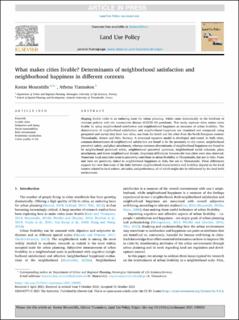What makes cities livable? Determinants of neighborhood satisfaction and neighborhood happiness in different contexts
Peer reviewed, Journal article
Published version
Date
2021Metadata
Show full item recordCollections
Original version
10.1016/j.landusepol.2021.105855Abstract
Shaping livable cities is an enduring issue for urban planning, which came dramatically to the forefront of relevant policies with the coronavirus disease (COVID-19) pandemic. This study explores what makes cities livable by using neighborhood satisfaction and neighborhood happiness as measures of urban livability. The determinants of neighborhood satisfaction and neighborhood happiness are examined and compared, using geospatial and survey data from two cities, one from the South and the other from the North European context: Thessaloniki, Greece and Oslo, Norway. A structural equation model is developed and tested. In both cities, common determinants of neighborhood satisfaction are found to be the proximity to city center, neighborhood perceived safety, and place attachment, whereas common determinants of neighborhood happiness are found to be neighborhood perceived safety, neighborhood perceived quietness, neighborhood social cohesion, place attachment, and lower neighborhood density. Important differences between the two cities were also observed. Numerous local amenities seem to positively contribute to urban livability in Thessaloniki, but not in Oslo. Parks and trees are positively linked to neighborhood happiness in Oslo, but not in Thessaloniki. These differences support the view that some of the links between neighborhood characteristics and livability depend on the local context related to local culture, attitudes, and preferences, all of which might also be influenced by the local built environment.
